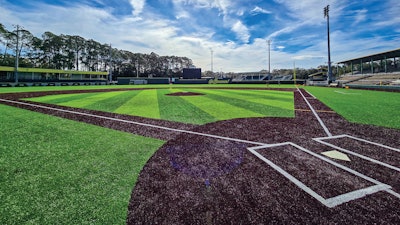
As the name would suggest, Scotts Miracle-Gro Athletic Complex at Johnson & Wales University in Providence, R.I., is the all-natural home to the Division III school’s baseball and softball facilities. And that’s just fine with assistant baseball coach John Casey, even though Casey had led a conversion from grass to synthetic turf at the end of his 38 seasons as head coach at his alma mater, Tufts University — 55 miles to the north in Medford, Mass.
He left to join his son’s staff at J&W before ever coaching a game on the wall-to-wall turf surface at Sol Gittleman Park, which opened at Tufts in 2023. That said, Casey, the current chair of the American Baseball Coaches Association Board of Directors, a past ABCA president (2016) and an ABCA Hall of Fame inductee (2020) — has seen every possible playing field configuration imaginable while amassing 765 career victories.
When asked why he specified synthetic turf for Gittleman Park, Casey cites New England Small College Athletic Conference scheduling and the region’s unreliable weather. “Honestly, it’s really hard to get 40 games in with the NESCAC restrictions on start dates,” he says. “And then you’re assuming everything’s perfect.”
In addition, maintaining the former grass field at Tufts taxed his student-athletes’ free time. Casey’s players did everything from pulling the tarp off the field to painting the fences and dugouts. “We didn’t cut the grass, but we did the dirt — mound, plate, bullpens. We did all that stuff,” he says. “Every fall we would have what we called Field Day, where we’d go out, we’d edge the warning tracks, edge the whole field — infield, outfield, everything. Did whatever we needed to do. We took ownership of that field.”
 Photo of the Staten Island Yankees’ Staten Island University Hospital Community Park courtesy of Beam Clay
Photo of the Staten Island Yankees’ Staten Island University Hospital Community Park courtesy of Beam Clay
Unnatural selection
Anyone taking ownership of ballfield construction or renovation in 2025 has options. Much has changed since 1966, when the Houston Astrodome introduced baseball to the great indoors and an unnatural surface — essentially nylon patio carpet with areas of traditional diamond clay cut out for the pitcher’s mound, home plate and bases.
Less than two decades later, 10 of Major League Baseball’s 28 teams were playing on synthetic turf. Today, just five of 30 do. But acceptance has increased steadily at the collegiate level, with the vast majority of programs now opting for synthetic surfacing over natural grass and dirt.
The reason? “Playability,” says Aaron Klotz, national director of baseball for AstroTurf, the synthetic turf brand that started it all nearly 60 years ago. “The season starts so early [Feb. 14], and weather is an issue, especially for the northern teams.”
Klotz says AstroTurf currently has more than 70 NCAA Division I playing fields “in the ground.”
“I know several college programs right now, they’re on the field if it’s 30 degrees,” he adds. “If it’s turf, they can do that. If it’s natural grass and clay, they can’t do that.
Southern programs see the benefit of synthetics, too. Says Klotz, “We just wrapped up the University of Georgia, and in the SEC they have nice weather, but they play in a wetter climate. They have more rain, not cold and snow. So, at the end of the day, playability and availability of the field wins out. That’s the whole idea.”
Availability means getting on a field in cold temperatures or after significant rains, but it can also mean repetitive use in ideal weather. “A collegiate team is going to use it in the fall and the spring. It’s sitting there May, June, July, August,” Klotz says. “You can use the synthetic turf baseball field in the summertime more than you can a natural grass one. Most of the collegiate programs we have, they’ll rent their fields out for 25 games a weekend. They’re not doing that with natural grass.”
Rental fees are not going to come close to covering the cost of a turf installation, Klotz admits, but they can be a significant revenue stream for schools. “They’ll host these tournaments Thursday, Friday, Saturday and Sunday. They start playing games at 9 a.m. and probably go five or six games a day,” he says. “All of a sudden, the school has found a way to make some money on that surface that’s just sitting there in summertime.
“It’s a win-win for the colleges. What better opportunity as a collegiate program and coach than to have a turf field that you can let others come and use? You can bring 25 to 30 teams to your campus, show them your home facility, watch them play on your field and recruit them a little bit. It’s kind of like an open house for these guys.”
 Photo of the Long Island Ducks’ Fairfield Properties Ballpark courtesy of Beam Clay
Photo of the Long Island Ducks’ Fairfield Properties Ballpark courtesy of Beam Clay
Old school
Traditionalists will argue nothing beats playing baseball on a natural grass field, where 90% of the game is played not on grass, but on the dirt comprising the mound, plate and basepaths.
Few people on earth know more about dirt than Jim Kelsey, president of Beam Clay, the Great Meadows, N.J.-based manufacturer that has supplied every MLB team with product.
A natural infield features 44 tons of material per inch of depth, and most infields measure four to six inches deep. “Clay” is the word used to describe the dirt portions of an infield, but even the most clay-heavy infield mixes feature only 25% of the material. Less than 10% of premium mixes is silt (extremely fine sand), with the balance consisting of coarser sand. The goal, according to Kelsey, is to create a soft surface over a firm base — a balance that requires expert maintenance techniques in the form of watering, tamping and raking. The sandier a field, the easier it is to maintain.
In the event a game is canceled, an unplayable infield is the likely culprit.
“Often people think that by having more clay, the field’s not going to drain, but your primary drainage is surface drainage,” Kelsey explains. “So, one of the most important things is to maintain that slight slope from the pitcher’s mound out — half to 1% out in all directions from the mound, so the rainwater can get off the field quickly. Oddly enough, the fields with the highest clay content are usually the ones that folks can get on the quickest.”
Such high concentrations of clay are used by those at the upper levels of competition, including MLB clubs. “They’ll go higher because they’re using large quantities of conditioners,” Kelsey says. “If you go higher in silt and clay, you need a lot of conditioner to make it easier to maintain the field.”
Conditioners are additives that can improve the performance of the infield mix. Says Kelsey, “The most popular ones are the calcined clays or the vitrified clays. Those are clays that go through a fine grinding process and then a heat process, which, because of the type of material they are, expands them into permanently porous particles, which improve drainage in an infield mix. While they’re promoting drainage, they also retain a certain amount of moisture in them, and then as the field dries, gradually releases moisture, so it cuts down on watering and makes the field playable longer.”
One infield materials supplier touts the naturally porous properties of pumice. The material, mined from ancient volcanic eruptions in Idaho, forms the key ingredient in Diamond Dust 4-in-1, which the company says provides superior drainage, durability and playability, even after rain. According to Melissa Moxley, Diamond Dust 4-in-1’s vice president of product marketing and communications, the pumice-based infield material can reduce maintenance costs by 50% when compared to clay, sand and silt mixes.
Even something as old as dirt can see technological advancement. Within the past 10 years, polymerized clay has entered the marketplace through a process that spreads individual particles of pulverized and screened clay on a conveyor and spray coats them with a polymer. The product is still 97% clay and only 3% polymer — bound together through applied heat — but it’s enough of a modification to make the clay a preferred choice. “We really recommend it for synthetic turf ballfields,” Kelsey says. “It repels water. It doesn’t need any water to install it or maintain it, and it just stays properly playable. It really cuts down on maintenance and basically eliminates tracking onto the synthetic turf. The clay doesn’t stick to spikes, and when it rains, it doesn’t run off onto the field.”
 Photo of Appalachian State University’s Beaver Field at Jim and Bettie Smith Stadium courtesy of AstroTurf
Photo of Appalachian State University’s Beaver Field at Jim and Bettie Smith Stadium courtesy of AstroTurf
Fielder’s choices
As suggested by Kelsey, fields can feature synthetic turf and dirt, just as in the old Astrodome days. Moreover, today’s fields may feature both natural grass on the infield and synthetic turf in the outfield, or vice versa.
Often these hybrid installations come down to budget, according to Klotz, adding that AstroTurf installs only full synthetic fields or synthetic infields. “It just costs less,” he says of the latter option. “Maybe they have great outfield grass. It drains well. When you can’t play the game, it’s because of the clay, so that’s why everything’s synthetic throughout those areas.”
Playability is one thing, but how a field actually plays dives even deeper into the science of synthetic turf systems. And perhaps no sport requires more fine-tuning than baseball.
“Football is worried more about traction, rotational resistance, the ability to start and stop and cut and not slip,” Klotz says. “Baseball has those characteristics, as well, but baseball is more interested in how we can get a ground ball to the shortstop and, on the average, not have it be too slow or too fast.”
To that end, fiber specifications and infill ratios can be tweaked to make sure batted balls react properly to the field. Klotz describes the typical exit speed of a batted ball at 90 miles per hour, and assuming the ball makes its first contact with the field within 20 feet of home plate, it will get to the shortstop in about 2 seconds. Most infielders can then field and throw the ball to first base in another 2 seconds, beating the time — about 4.5 seconds — that it takes the average batter to run to first base.
“Knowing those numbers, what do you do with them? Well, we know based on sand and rubber ratios that we put in the turf, we can make it hit those metrics and those times, or we can make it slower,” Klotz says. “You’re not going to make every ball in this game match those numbers, because there’s obviously so many different angles a baseball can be hit. But when we infill a field, we have an idea of the times that we want to be at. That’s when I come out and I help test these fields with the coaches. The coach says, ‘That field’s not fast.’ And I can say, ‘Well, coach, here are the numbers. Our eyes can show us one thing, but the data and the clock don’t lie.’ That’s how we tune it in.”
 Photo of the University of Iowa’s Banks Field courtesy of AstroTurf
Photo of the University of Iowa’s Banks Field courtesy of AstroTurf
And unlike a synthetic turf football field, a baseball diamond has different zones that require different design specs. The green “grass” areas on an AstroTurf field feature a blend of fibers (a 2-inch fiber and a shorter so-called root zone) at a face weight of 60 ounces per square yard and supported by a 50-50 mix of sand and rubber infill. The brown infield “clay” areas feature AstroTurf’s patented diamond-shaped 10-ply monofilament fiber that stands at an inch and a half but is designed to lay over. This fiber features 70% nylon to better withstand metal spike traffic. It exhibits the same face weight as the green turf but is protected by a slightly different infill mix of 60% sand and 40% rubber. Just three years ago, the face weight was bumped up to a “beefy” 90 ounces on the mound and in the home plate area for even greater durability, says Klotz, who adds that maintenance in the form of regularly brooming these high-traffic areas adds to their longevity.
Infill depth should be a consistent 70% of the fiber height for ideal protection of the entire turf system. “That sand and rubber is really there: one, for performance, but two, it’s protecting the makeup of the system, and when the system loses its characteristics and makeup, it’s not going to last,” Klotz says. “That’s when the carpet’s going get damaged.”
An alternative product now on the market eliminates infill altogether. “Pivot® Performance Turf requires no rubber pellets. Therefore, it offers a more consistent and predictable playing surface and pace of play,” says Ryan Reid, director of baseball at TenCate Americas. “Free from low or high infill areas, Pivot ensures a true and reliable experience for athletes.”
 Photo of the University of Pittsburgh’s Charles L. Cost Field courtesy of AstroTurf
Photo of the University of Pittsburgh’s Charles L. Cost Field courtesy of AstroTurf
Reid says that the product can still be customized to meet the faster or slower preferences of coaches and players for both infield and outfield play. It is currently featured at eight installations in the U.S., mostly in the South, with half being infield-only installs. “We’ve installed a number of fields, and players and coaches have appreciated the comfortable, grass-like feel and excellent sliding capabilities,” Reid says.
Back in Rhode Island, Casey acknowledges that the natural fields at Scotts Miracle-Gro Athletic Complex take more work to maintain their ideal playing conditions, but that’s always been his preference — even if he did champion the installation of AstroTurf at Tufts. “I’ve been doing this for a long time, so I like to take care of my own field,” Casey says. “It was one of those things — for guys to work on the field together and bond. When you take care of something and invest in it, then you sort of just instinctively play harder, because it’s yours.”
When specifying a ballfield surface, it all comes down to the desires of the end-user.
“What is the practical use of your facility, and what are you trying to do with it?” Klotz asks. “If I’m building a Major League stadium that can use natural grass, I’ll be the first to admit that everybody understands a perfectly well-groomed field with natural grass and clay is great for baseball. But if there’s a situation that says, ‘We want to do more than the average,’ that’s when people really look at synthetic.”
They might just find the best of both worlds, according to Klotz. “You have a system now that’s basically replicating grass, where before you just had a carpet. You rolled it out, and said, ‘Here you go. Play on it.’ Now we can tailor pile heights. We can tailor infill depths and ratios. We can figure out how this can be faster or slower based on the chemistry of the turf. The old stuff was just our patio carpet. The new stuff is a totally engineered system to get the surfaces to play just like perfectly maintained Bermuda grass.”






































